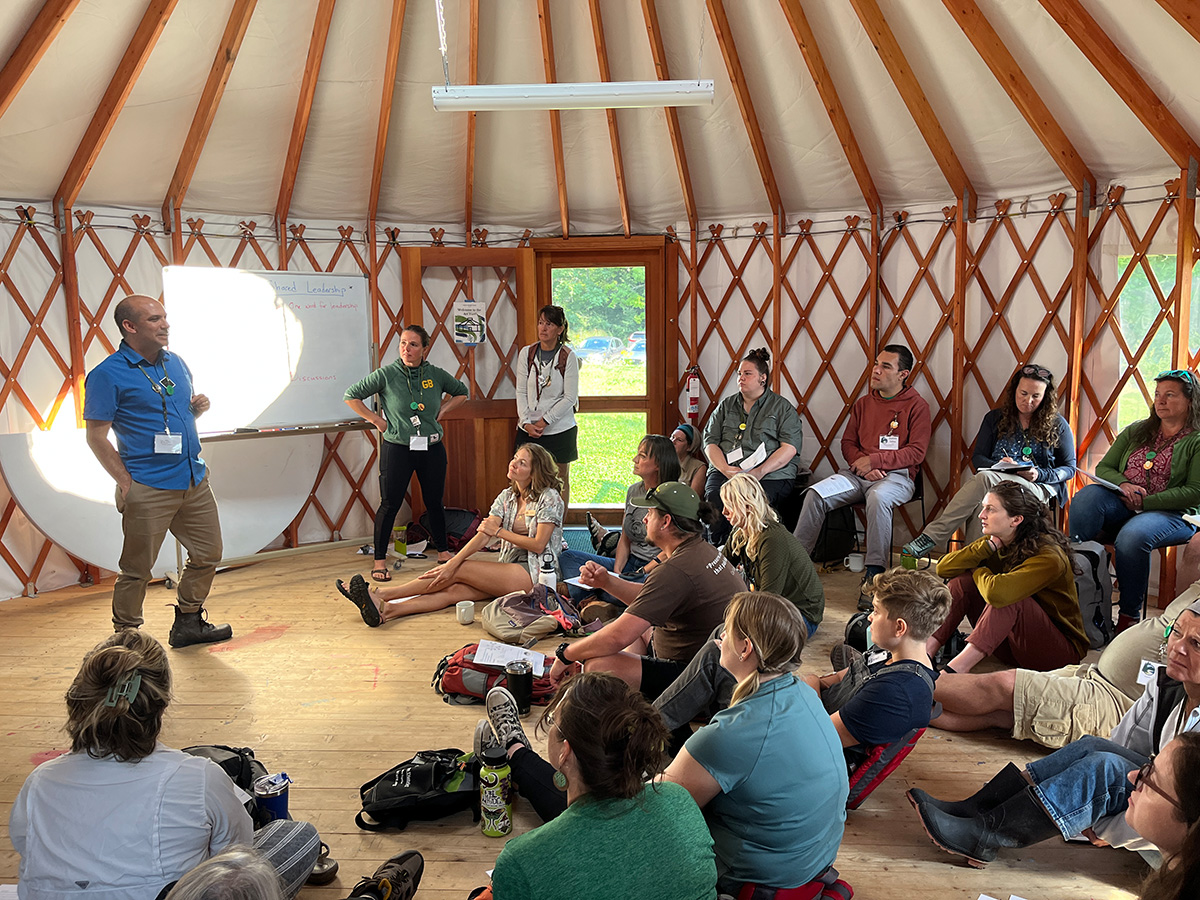Glenna Holstein, Independent
Mike Larson, Executive Director of the Blue Lotus Center in West Bend, Wisconsin
Glenna Holstein and Mike Larson are both ANCA members based in Milwaukee, Wis. They met 15 years ago working together at the Urban Ecology Center in Milwaukee, where they became fast friends as they connected over shared values and curiosity about how to become the best leaders they could for their respective teams (and arguably over their shared nerdy sense of humor). A decade and a half later they still love geeking out about ideas and practices of shared leadership. Glenna and Mike led a session on shared leadership at the 2023 ANCA Annual Summit; this article summarizes what they discussed in the session.
 Glenna Holstein and Mike Larson facilitate a discussion on shared leadership at the 2023 ANCA Annual Summit.
Glenna Holstein and Mike Larson facilitate a discussion on shared leadership at the 2023 ANCA Annual Summit.
Ask a room of 30 people what makes a good leader, and you might get 30 different answers.
That’s one of the things that makes leading a team so tricky: different people value different things. As capable and intentional as you might be, it can feel truly impossible to be the “right” leader for everyone. It’s a pretty intimidating prospect, when you think about it! Having to be everything to everyone, see things from all angles, make all the decisions, as just one person?
Here's the good news: we’re convinced that you don’t have to do it all. In fact, it can be more effective, more fulfilling, and more motivating when you share leadership on your team.
Why shared leadership?
We could literally talk all day about why we love shared leadership, but the basic summary is this — sharing leadership on your team:
- Makes your job easier (you don’t have to make all the decisions by yourself!)
- Builds trust and buy-in among your team (if you’re making decisions together, everyone has a say and a stake.)
- Makes your decisions better (you get multiple perspectives and often come up with ideas you couldn’t come up with on your own.)
- Builds new leaders (everyone on your team will be gaining the skills they need to lead, both on your team and in any future role they may have.)
- Makes everything more fun (this is subjective, but we definitely think so!)
Types of Team Structures
Hierarchy & Crews
Many of us are familiar with the traditional corporate hierarchy prevalent in most organizations. Smaller organizations might get away with more of a “crew” model: a number of employees reporting to one boss or director.
While both of these models can be effective, they also have significant weaknesses. Have you ever been frustrated by a decision made up the corporate ladder that didn’t make sense to the front line staff who had to implement it? Or, have you ever had a supervisor who faced problems outside of their depth that they didn’t know how to handle? Both of these problems stem from a model of leadership that concentrates decision-making power and authority in one person. As long as that person is competent, benevolent, and well informed, everything seems to go fine and they often get a lot of credit. However, when they make a mistake, they also receive all the blame.
Collaborative Teams
Hierarchies are not the only way to organize. In a collaborative team model, a group of people work together to make decisions, prioritize workstreams, and assign tasks. In this model the leader does not hold the power, they hold the space — acting more as a facilitator of the conversation than the boss.
From Mike: This style of leadership was modeled for me by my first real mentor. Whenever I came to her with a question or problem she would always respond by asking: “what do you think you should do?” This simple question shifted the power dynamic in our relationship. I quickly learned to come to her with solutions, not just problems, and she empowered me to have agency and take responsibility for their actions. When I became a manager myself, I was able to apply that same strategy with my team. Whenever a question or problem would arise, we would bring the team and I would ask “what do you think we should do?” It was cool to see many brains coming together to meet the challenge and often the solutions they came up with were way better than I would have come up with on my own.
This type of dynamic just doesn’t happen organically. It requires intentionality and a foundation of trust built over time, especially if transitioning from a traditional hierarchy or crew style model. Fortunately, there are a number of tools to help facilitate a highly effective and collaborative team. Two models/resources we have found useful in developing our own sense of organizing teams are Teal Organizations and Sociocracy.
Teal Organizations
A “Teal” organization is loosely modeled after a living organism, focusing on self management (high autonomy, strong peer relationships, power embedded throughout organization), wholeness (creating an environment where people can bring their whole selves to work), and evolutionary purpose (defining purpose of work is a process of observation, exploration and discovery in which everyone participates). For more on Teal organizations, see the book “Reinventing Organizations” by Frédéric Laloux.
Sociocracy
Sociocracy is a system of dynamic governance that aims toward equitable, efficient, and collaborative decision-making. One of the major principles of sociocracy is organizing work and teams in “circles” –each of which is a group with decision making authority in their own area (for decisions which affect other areas, they must involve other circles in the decision).
Key elements of the circle structure are that each circle has a facilitator and that the circles are “double linked” going outward from the center — each link represents two people who are part of both the inner and outer circle, to ensure information flows between circles and that decisions are not made without the voice of adjacent circles being present.

From Glenna: In one of my previous roles, I experimented with organizing my team in circles, as seen above. This structure worked well for me because I was doing membership work that needed engagement across the organization but I was technically a department of one. The circles allowed me to involve and empower folks with different areas of expertise in different areas of membership, while promoting a flow of information among areas and ensuring cohesion via the central strategy team.
How to make decisions as a team
No matter how you decide to organize your team (or whether your team’s structure is predetermined by your organization), you will need to figure out how your team makes decisions together in order to effectively share leadership.
Choose your style
There are many decision making styles, but a good way to get a sense of the range is to think about “directive” decision making (one person makes the decision and hands it down to the team) on one end of the spectrum and “consensus” decision making (decision made by mutual agreement of all parties) on the other end. Directive decision making has the benefit of being quick and clear, but it can also have the downsides of having lack of team buy-in, and feeling frustrating. Consensus decision making has the benefit of buy-in and engagement, but can sometimes feel cumbersome as a process.
Collaborative decision making
In our experience, a collaborative approach to decision making can help find the sweet spot between the two extremes. Essentially, this means working with your team together to “decide how we decide.” Together, your team will come up with clear guidance about what kind of decisions might be directive and who makes them vs. which ones will be made together as a group (and how you will walk through that process together), vs. which one might be made by one person with the input of others.
For example, decisions about safety need to be made quickly and will likely be made directively. Decisions about how to allocate budget among different needs within your team might be made together as a group. And decisions about a specific project someone on your team is working on might be made by one person with input from others.
Consent-based decision making
One tool we have found particularly useful for making decisions as a team also comes from Sociocracy — it’s called consent-based decision making. When done well, this process gives everyone a voice without being too cumbersome.
The key to the process is the idea of the “range of tolerance.” Typically when making group decisions we come into the conversation aiming for our own personal preference. But in a consent-based process, we don't ask “what do you prefer?” we ask “is this in your range of tolerance?” or “do you object?”
The distinction seems slight but to illustrate the difference it makes, take the example of trying to decide what to have for dessert. Imagine someone’s preference for dessert is chocolate ice cream, but their range of tolerance might be anything with chocolate in it. So by making that slight shift to “range of tolerance,” we give ourselves vastly more area to work within to make our decision.
A consent-based decision-making process usually looks something like this:
- Someone presents an idea or proposal to the group (may have been shared with group beforehand, depending on complexity)
- Group has a chance to ask clarifying question
- Group does a quick round for reactions. In sociocracy, a “round” is a specific tool: you go around the group in a circle and give each person a chance to speak in order before there is any cross talk. This balances introvert and extrovert communication styles and ensures that you hear from everyone.
- Consent decision-making round: People can say “I consent” or “That’s within my range of tolerance” to consent to the decision, or “I object” if they have an objection. Note objections if there are any.
- Integrate objections until the proposal is in everyone’s range of tolerance, or identify steps to get it there by the next meeting.
Your role as a leader in this model is to facilitate these processes, as opposed to being the one making the decision.
From Glenna: I helped facilitate consent-based decision making for our organization’s COVID response team. While I initially worried that the “consent, object, range of tolerance” language and the rounds would feel onerous, it actually had the opposite effect. Once we had the shared language and understanding, we could actually make decisions more quickly. We came up with a color-coded shorthand for “preference” (green), “range of tolerance” (yellow), and “objection” (red). We could often do a really quick visual poll on the zoom screen (we each had colored pencils or scraps of paper that we would hold up) to see how close we were to consenting on a decision.
From decisions to process
Whatever guidelines and processes your team comes up with, the main point to remember is that your decision-making has to be intentional and inclusive. As a leader you are shifting your role from being the one who makes all the decisions to the one who holds a space for the process. Will your team decide to do things you wouldn’t have decided on your own? Absolutely. Will that be uncomfortable sometimes? For sure. Will there also be times where you are amazed and delighted by the things your team comes up with that you never would have thought of by yourself?
We guarantee it.
For more on shared leadership, join us for an ANCA CONNECTS program on this topic, December 13, 2023. Learn more >
Additional Resources
The Future of Management is Teal
An introduction to Teal Organizations.
Reinventing Organizations Wiki
A site based on the book “Reinventing Organizations” by Frédéric Laloux.
Sociocracy – Basic Concepts and Principles
An introduction to Sociocracy.
Advertisements




